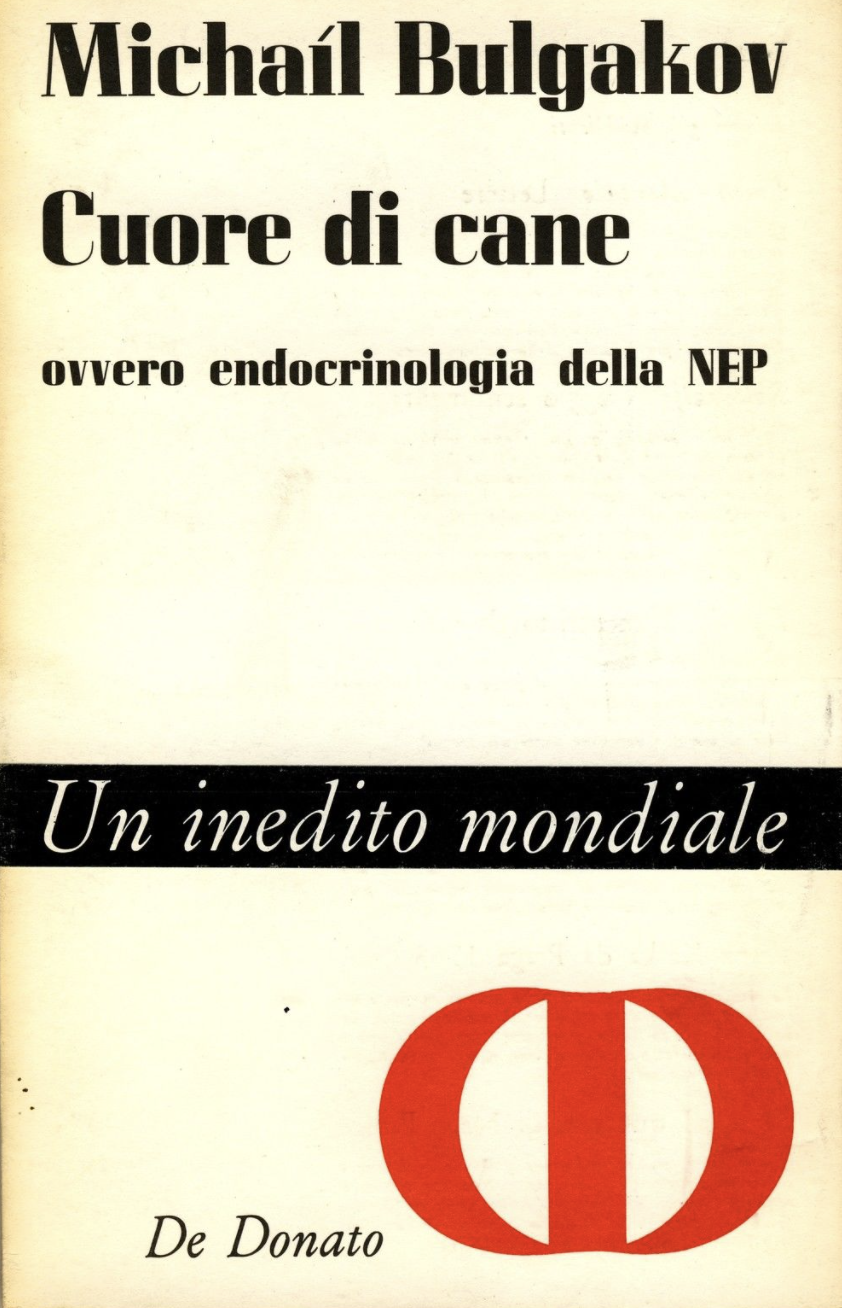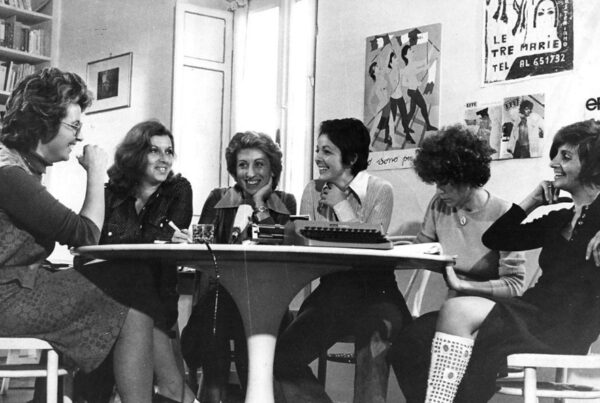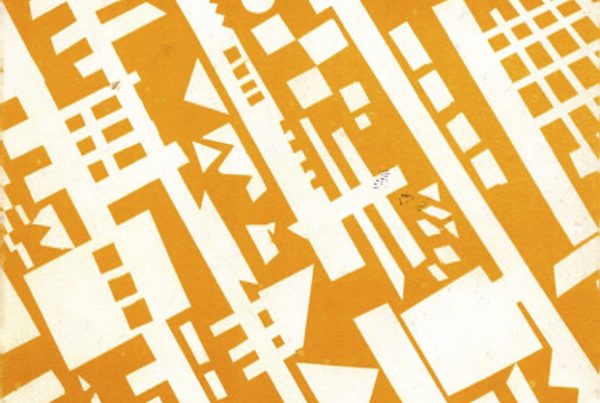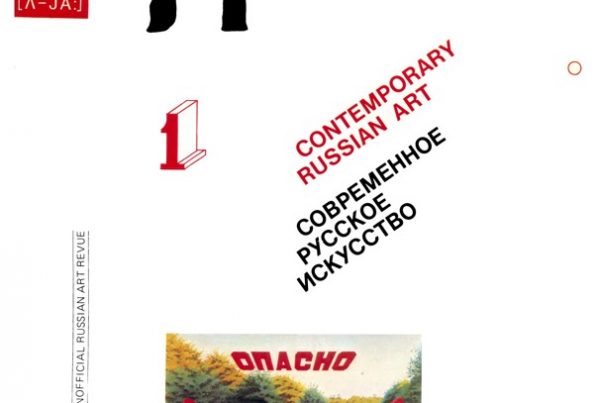Title:
Sobach’e serdtse [The Heart of a Dog]
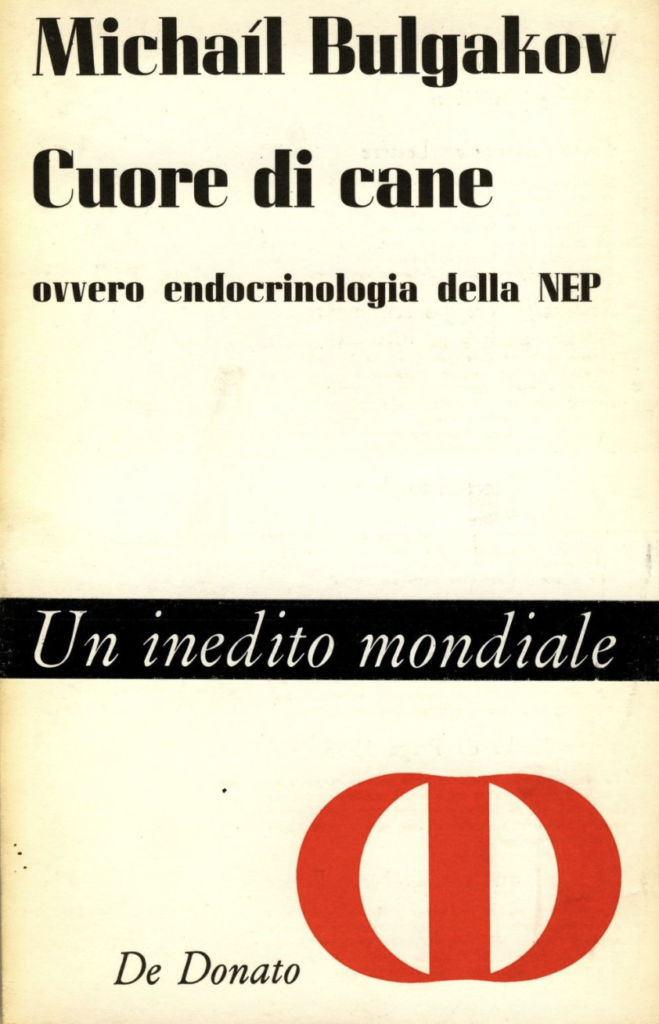
“The Heart of a Dog”. Cover from the De Donato edition, 1967.
Author: Mikhail Afanasevich Bulgakov (1891-1940)
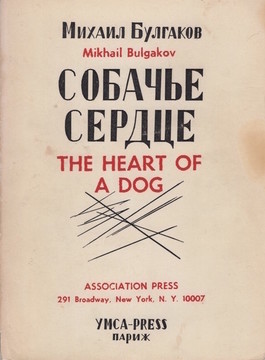
“The Heart of a Dog”. Cover from the YMCA-PRESS edition, 1969.
Drafting: 1925 (March-January) and 1937
Year of the first publication in Russian: 1968
Publisher: Flegon Press
Place of Publication: London
First edition: 1968
Description:
Mikhail Bulgakov wrote Sobach’e serdtse (The Heart of a Dog) between January and March 1925, after he publicly spoke against censorship and Soviet bureaucracy in the first NEP phase. Not surprisingly the events of the story occur in Moscow in December 1924 and have as leading characters doctor Preobrazhenskii, his assistant Bormental and Sharik, a dog who they have subjected to a hypophysis transplant that causes him to metamorphosize into Poligraf Poligrafovich Sharikov, a humanoid who embodies the distortions of the new Soviet regime. The Bulgakovian novella was influenced by eugenics and gland transplants of which the emigrated Russian biologist Sergei Voronov (later Serge Voronoff) and the Viennese Eugen Steinach were pioneers. The novella can be placed in a specific current of European science-fiction, which included several well-known contemporaries such as Herbert G. Wells with The island of Dr. Moreau and Italo Svevo with The regeneration (cf. Giuliani 2018: 2-4). Bulgakov, who had recently experimented with an historical framework in Belaia Gvardiia (The white guard), which was partly published in “Rossiia” in 1925, had already written a work of science fiction in 1924 in the form of the novella Rokovye iaitsa (The fatal eggs), published in “Nedra” (n.6, 1925) which was edited by Nikolai Angarskii. Nedra could not publish Heart of a dog, as the novella combined science-fiction with a clear critique of Soviet power (cf. Strada 1967:8).
Bulgakovian satire, until now expressed through the genre of feuilleton, overstepped the limits of tolerability with The Heart of dog. Lev Kamenev immediately blocked circulation of the novella and on 7th May 1926, the OGPU under Feliks Dzerzhinksii searched Bulgakov’s flat and confiscated the manuscript of Heart of a Dog with the writer’s diaries. In the same period Bulgakov was becoming popular at MChaT, where they proposed staging a theatrical adaptation of the novella (the agreement was signed on 2nd March 1926 and annulled on 19th April 1927). The theatre staged Dni Turbinykh (The days of the Turbins), a theatrical adaptation of The white guard, which was much appreciated by Stalin, to the extent that in 1932 the work was saved from censorship, after the interruption of the play in 1929. In the late Twenties, Bulgakov started Master i Margarita and thanks to Maksim Gorkii, the handwritten copy of Heart of a Dog was returned to him, which he reworked between 1935 and 1937 without making substantial changes. Heart of a Dog was not published in the writer’s lifetime, and after his death, it circulated for a long time via samizdat channels. Today, three drafts of the novella survive. It was only in 1967, after the publication and success of The Master and Margarita, according to Montale, a “disconcerting” novel (cf. Baselica 2019), that drafts of Heart of a Dog arrived in the West, which, according to the writer’s widow, Elena Bulgakova, were not reliable, a recurring risk for works circulated only in samizdat. Towards the end of 1967, the text was issued in Italian by the publisher De Donato in Bari, translated by Maria Olsoufieva with the contribution of Chiara Spano De Cet (cf. Bulgakov 1967). Thanks to a new edition of The white guard and the first publications of The Master and Margarita and Heart of a Dog, 1967 was coined “the year of Bulgakov” (cf. Ripellino 1967: 11). Nevertheless, on 5th of December 1967, Vittorio Strada writing for “L’Unità”, recognized the philological limits of the first translation of Heart of a Dog: “in the Soviet Union it has not yet been published. However, the typewritten text circulates in Moscow and elsewhere, and one of the copies which arrived in Italy was translated. We hope that a new Soviet edition of this novella will allow not only Soviet readers to know it but also give us as a reliable text” (Strada 1967: 8). In the Soviet Union another twenty years would pass before the work was officially published. The first editions in Russian, which differed considerably, were published in 1968, first in London in nos. 9 and 10 of the magazine “Student-zhurnal avangarda sovetskoi literatury” and then in Frankfurt am Main in no. 69 of “Grani”; this second version was rather incomplete. With the collaboration of Elena Bulgakova, the draft published by “Student” was edited and published in an independent edition by YMCA-Press in Paris in 1969 (cf. Tamizdat). In the following years, Heart of a Dog was adapted for cinema with a script written by Alberto Lattuada (cf. Bulgakov 1975); his adaptation, screened in 1976, featured Max von Sydow as Preobrazhenskii and was positively received by critics. During this period in Italy there were new translations and conferences dedicated to the Bulgakovian work, with detailed critical studies of the text (cf. Ripellino 1975; Spendel 1985; Böhmig 1985), while in the Soviet Union, The Heart of a Dog was published in 1987, in issue no. 6 of “Znamia”, using a draft edited by Marietta Chudakova. Soon afterwards, in 1988, a television adaptation by Vladimir Bortko met an appreciative mass audience, earning Heart of a Dog status as an object of worship. Only in 1989, thanks to research led by Lidiia Ianovskaia, in the collection in two volumes M. Bulgakov, Izbrannye proizvedeniia (Kiev, Dnipro publisher), was a complete and revised draft published, which reflected the last will of Bulgakov.
Marco Sabbatini
[30 June 2021]
Translation by Diletta Bacci
Bibliography
- Baselica G., Bulgakov nell’Italia della contestazione, “Rivista Tradurre”, 16 (2019):https://rivistatradurre.it/2019/05/michail-bulgakov-nellitalia-della-contestazione/, online (last accessed: 30/06/2021).
- Böhmig M., Gli antenati di Poligraf Poligrafovič Šarikov: un aspetto dei legami di Bulgakov con Gogol’, Hoffmann e Cervantes, in E. Bazzarelli e J. Křesálkováin (eds.), Atti del convegno “Michail Bulgakov” (Gargnano del Garda, 17-22 settembre 1984), Istituto di Lingue e Letterature dell’Europa Orientale – Università degli Studi di Milano, Milano 1985: 29-46.
- Bulgakov M., Cuore di cane: ovvero endocrinologia della NEP, it. transl. and ed. by M. Olsoufieva with the collaboration of C. Spano De Cet, De Donato, Bari 1967.
- Bulgakov M., Cuore di cane. Il romanzo e la sceneggiatura di Alberto Lattuada, it. transl. by M. Olsoufieva, critical review by L. Lombardo Radice, De Donato, Bari 1975.
- Ripellino A. M., L’anno di Bulgakov, review to: M. Bulgakov, La Guardia bianca, transl. by E. Lo Gatto, Einaudi, Torino 1967 and M. Bulgakov, Cuore di cane: ovvero endocrinologia della NEP, it. transl. by M. Olsoufieva with the collaboration of C. Spano De Cet, Bari, De Donato,1967], “Corriere della sera”, 26/10/1967: 11.
- Ripellino A.M., Introduzione, in M. Bulgakov, Cuore di cane: La storia di un uomo-cane nella Mosca del 1925, it. transl. by G. Crino, BUR Rizzoli, Milano 1975: 9-15.
- Spendel G., Grottesco quotidiano e pessimismo avveniristico nel primo Bulgakov, in E. Bazzarelli e J. Křesálková (eds.), Atti del Convegno “Michail Bulgakov” (Gargnano del Garda, 17-22 settembre 1984), Istituto di Lingue e Letterature dell’Europa Orientale – Università degli Studi di Milano, Milano 1985: 541-552.
- Giuliani R., Il tema del ringiovanimento in Michail Bulgakov e in Italo Svevo (Cuore di cane e la rigenerazione), “Toronto Slavic Quarterly”, 64 (2018): 1-16. http://sites.utoronto.ca/tsq/64/Giuliani64.pdf , online (last accessed: 30/06/2021).
- Strada V., L’uomo-bestia del nuovo Gogol, “L’Unità”, 05/12/1967: 8.
- Tamizdat, Michail Bulgakov, http://tamizdatproject.org/ru/author/mikhail-bulgakov, online (last accessed: 30/06/2021).
To cite this article:
Marco Sabbatini, The Heart of a Dog (M. Bulgakov), in Voci libere in URSS. Letteratura, pensiero, arti indipendenti in Unione Sovietica e gli echi in Occidente (1953-1991), a cura di C. Pieralli, M. Sabbatini, Firenze University Press, Firenze 2021-, <vocilibereurss.fupress.net>.
eISBN 978-88-5518-463-2
© 2021 Author(s)
Content license: CC BY 4.0
